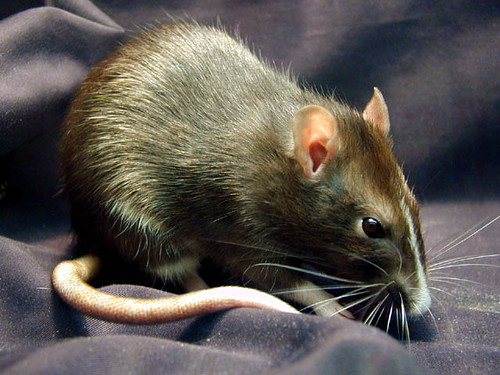
Pet rats are varied in color including black, white, chocolate, cinnamon etc. They can also have various markings. Hair can be short,long, curly, fine, rough and even hairless. There are also two "dumbo" rats, which have larger ears that are offset from the head as compared to standard rats. Typically, "fancy rats" is the title given to domesticated pet rats. Life span is about 2-3 years.
Rats are very social and should at least be kept in pairs. Rats should never be without a cage mate, unless the rat has proven to be aggressive towards other rats. Rats are more mellow than mice and more intelligent. They enjoy being held and are easier to train. If a rat escapes, they often return to their cages if it is reachable. Paper towel and toilet rolls make fund toys for them to nibble on. As with all rodents, they love to gnaw and there are many wooden toys available for them.

Males tend to be more calm and peaceful and usually make a better "lap rat". Females, on the other hand, tend to be more energetic and fun loving.
Contrary to popular belief, male rats will not fight with each other as cage mates providing they have been properly introduced. For introducing rats, introducing younger rats to older ones is a much easier practice than introducing older rats together who have not already lived together.

Rat Behavior
Just like human beings, rats come in all shapes and forms. This also includes varying personality quirks and different behaviors. When in doubt about something you rat(s) are doing, do some online research or talk to your veterinarian. You may also wish to consult Rat Behavior and Biology

Happy rats engage in "bruxing", which is equivalent to a cats purring. When a rat bruxes, they are grinding their teeth together. However, if bruxing is louder than normal, it can also be a sign that the rat is in pain because rats typically can hide their pain and illness very well as part of their prey mentality.
Another sign of a happy rat is "boggling" which is quite the sight to see, quite literally! Boggling happens when intense bruxing pushes their eyeballs slightly out of their socket - so the rat looks temporarily a bit bug eyed. This is nothing to be concerned about but it can be a bit alarming for new rat owners to witness! It is simply a sign of extreme contentedness.

Rats are very intelligent and can find their ways into, and out of plenty of tight spaces. They will also systematically destroy objects within their grasp if they think it may be tasty or delicious. So if you have any valuables within reach of your rats, you may wish to move them out of harms way.
One reason that it is not recommended that a rat be housed alone is because their behavior can be negatively impacted. A solitary rat is more likely to become depressed and withdrawn and can also become more aggressive. Rats need companionship that no human owner can provide - they need another rat for grooming, cuddling and having fun together with.

Rats are capable of being trained to use a litter box, as well as can be trained to do some tricks and can be trained to come when their name is called. It does require a lot of patience to train an animal, but rats are very driven to perform, especially when a treat is used as an incentive.

